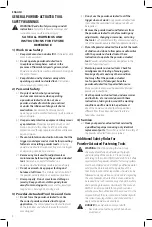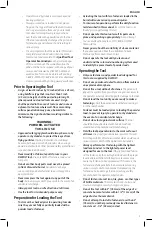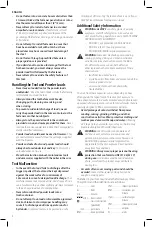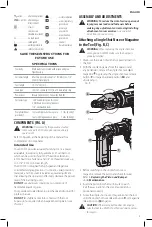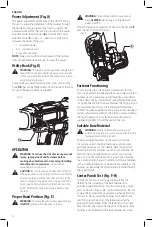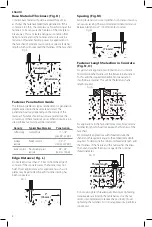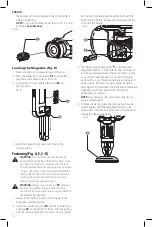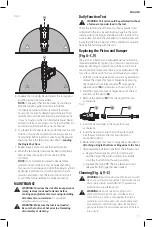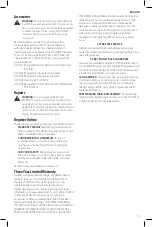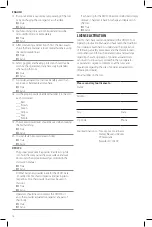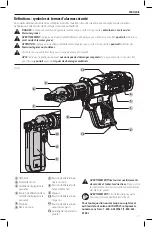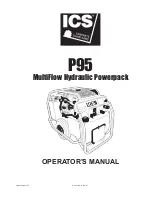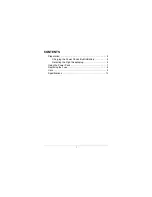
English
3
• Operators and bystanders must wear eye and
hearing protection.
• Always assume tool is loaded. Do not place a
finger on the trigger of loaded tool until muzzle
end is against work surface and you are ready
to make a fastening. Never place your hand
over the muzzle with a powder load in the tool.
If the tool accidentally discharges, the piston or
fastener may penetrate your hand resulting in
serious injury.
• It is very important that the operator of this tool
completely reads and understands the entire
tool manual and completes the
Qualified Tool
Operator Examination
on the last two pages
of this user manual. The warranty will not be
valid until the test is received, with a copy of your
receipt, and reviewed by
D
e
WALT
. Additional
examination forms can be obtained by calling
1‑800‑4‑
D
e
WALT
(1‑800‑433‑9258) or download
a new user manual by visiting www.dewalt.com.
Prior to Operating the Tool
•
A sign, at least 8 inches by 10 inches (20 cm x 25 cm),
using boldface type that is not less than 1 inch
(2.5 cm) in height, shall be posted in plain sight
where powder‑actuated tools are used.
A sign
shall be posted in the area of tool use and in areas
adjacent to tool use where wall, floor or working
surface penetration may pose a hazard. At a
minimum, the sign should bear wording similar to
the following:
WARNING:
POWDER‑ACTUATED
TOOL IN USE
•
Approved safety goggles should always be worn by
operator or bystander, to protect their eyes from
flying particles.
Hearing protection should always
be worn by the operator and bystanders when using a
powder‑actuated tool. Other personal safety protection as
required should also be used.
•
Never modify or fabricate parts for use in your
D
e
WALT
tool.
Use only
D
e
WALT
fasteners, loads, and
tool parts.
•
Hands or other body parts must never be placed
in front of muzzle/barrel.
Accidental discharge
can cause piston and/or fastener to pass through the
operator’s hand.
•
Never compress the tool against any part of the
body.
Serious injury or death may result in the event of an
accidental discharge.
•
Always point tool in a safe direction at all times.
•
Use the tool for its intended purpose only
.
Preparation for Loading the Tool
•
Tools must be checked prior to operating to make
sure they are not fully or partially loaded with a
powder load or fastener.
•
Actuating the tool with two fasteners loaded in the
barrel will cause serious personal injuries.
•
To insure safe operation, perform the daily function
test described in this manual.
Be sure the tool is not
loaded prior to performing this test.
•
Do not operate this tool unless all its parts are in
place and operating appropriately.
Never attempt
to use a malfunctioning tool. Call 1‑800‑4‑
D
e
WALT
for assistance.
•
Never guess about the suitability of a base material.
If you are uncertain about the suitability of a base
material, perform a center punch test.
•
Do not operate the tool until you learn and
understand the color code/numbering system used
to identify the power level of powder loads.
Operating the Tool
•
Only use fasteners and powder loads designed for
this tool as supplied by
D
e
WALT
.
•
Do not use powder‑actuated tools in a flammable or
an explosive atmosphere.
•
Do not fire a tool without a fastener.
The piston will
impact the work surface possibly causing serious injury to
the operator or bystanders along with damage to the tool.
•
Do not load the tool until you are ready to make a
fastening.
Check the power load level before inserting it
into the tool chamber.
•
Fastener must be loaded prior to loading the powder
load, to prevent injury to operator or bystander in
the event of an accidental discharge
.
•
Do not close tool against work surface.
The tool
should be manually closed, with hand away from
muzzle/barrel to prevent accidental discharge.
•
Hold the tool perpendicular to the work surface at
all times
. Use a spall guard wherever possible. This will
limit the possibility of fastener ricochet which could cause
serious injury or death to the operator or bystanders.
•
Always perform a test fastening with the lightest
load level, and set to the lightest power level
designed for use in the tool
. If the lightest load fails to
set the fastener, try the next highest load until the proper
level is attained. Failure to follow this procedure may
cause the fastener to be overpowered. If this occurs, the
fastener may fully penetrate the base material causing
serious injury or death to someone. Overpowering the
fastener can also damage the tool, creating a safety
hazard to both the operator or bystanders.
•
Do not fasten into cast iron, tile, glass, or other types
of brittle materials.
These materials can shatter and
create sharp fragments which may cause injury.
•
Do not fire tool within 3" (76 mm) of the edge of a
concrete base material or within 1/2" (13 mm) of the
edge of a steel base material.
•
Do not attempt to install a fastener closer than 3"
(76 mm) to another previously inserted fastener in
concrete or 1‑1/2" (38 mm) in steel.
Содержание DFD270
Страница 55: ......




